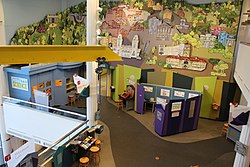EcoTarium
 | |
 | |
| Established | 1825 (as Worcester Lyceum of Natural History)[1] |
|---|---|
| Location | Worcester, Massachusetts |
| Type | Science museum |
| Website | http://www.ecotarium.org |
The EcoTarium is a science and nature museum located in Worcester, Massachusetts. Previously known as the New England Science Center, the museum features several permanent and traveling exhibits, the Alden Planetarium, a narrow-gauge train pulled by a scale model of an 1860s steam engine, and a variety of wildlife.
History
The EcoTarium was founded in 1825 as the Worcester Lyceum of Natural History.[2] The first spaces dedicated to the museum were the Natural History Rooms on the third floor of the Worcester Bank Block on Foster Street, which opened on October 1, 1867. In 1891 the museum and its collection moved to the Old Edwin Conant Mansion at the corner of State and Harvard streets.
As the collection grew more and more space was needed. In 1954 the museum moved exhibits to the Daniels House and the Rice House at 41 Elm street, both in Worcester. The final move took place in 1971 to a new building, designed by Edward Durell Stone, built on 60 acres (240,000 m2) of donated land. At this point the name of the museum was changed to the Worcester Science Center, then changed again in 1986 to the New England Science Center.
In 1998 the museum yet again changed its name to the EcoTarium, and began an $18 million expansion and renovation project which was completed in 2000.[3]
In June of 2016, the museum unveiled its "Third Century Plan," a $9.1 million capital campaign which will fund improvements to both its indoor and outdoor exhibits, programming, and infrastructure.[4] On January 17, 2017, the museum opened "City Science," one of two new exhibits being funded by its capital campaign.[5]
Former Exhibits
Until recently, one of the museum's most well-known exhibits was a polar bear named Kenda. Kenda died June 13, 2011. Kenda had developed kidney disease (a common disease in polar bears at zoos) and it was decided that she should be euthanized. With this, polar bears are no longer able to be seen in New England. [6] Kenda's mother, Ursa Minor, lived at the museum until her death in 2001 at the age of 36, making her one of the oldest captive polar bears.[7]
External links
References
- ^ "History". EcoTarium. 2011-07-26. Retrieved 2018-05-18.
- ^ "History". EcoTarium. 2011-07-26. Retrieved 2018-05-18.
- ^ "History". EcoTarium. 2011-07-26. Retrieved 2018-05-18.
- ^ Jr., Steven H. Foskett. "EcoTarium unveils fundraising campaign; plans new exhibits, upgrades". telegram.com. Retrieved 2018-05-18.
- ^ "EcoTarium's newest exhibit called City Science designed to discover science hiding all around". masslive.com. Retrieved 2018-05-18.
- ^ "Archived copy". Archived from the original on 2011-08-28. Retrieved 2011-06-15.
{{cite web}}: Unknown parameter|deadurl=ignored (|url-status=suggested) (help)CS1 maint: archived copy as title (link) - ^ http://www.ecotarium.org/ed/wildlife/aotm/archive/199912_pbear/index.html[permanent dead link]
42°15′50.8″N 71°46′00.5″W / 42.264111°N 71.766806°W

